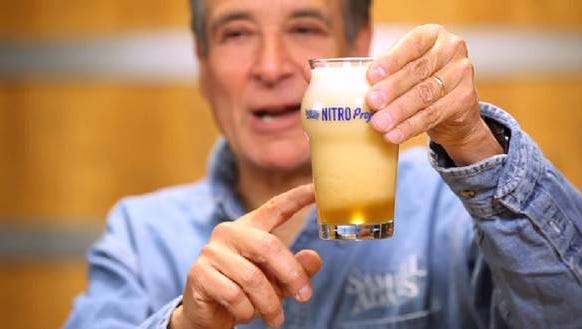Russo: Nitro-infused beer just another toy for craft enthusiasts

Setting aside the more obvious things like quality and economic benefit, what really sets craft beer apart is a sense of play.
If you have tried a lot of craft beers, or even if you have just read a lot of craft beer descriptions while out to dinner, you have seen some odd combinations. Craft brewers take chances, sometimes for the worse, but often for the better.
At the bottom of the chances brewers take with tastes and flavors is this notion that making beer should be fun, for the most part. Drinking beer should be fun for all the part.
Trying a beer “on nitro” is a place where those two parts of craft beer culture intersect.
Nitrogen is an alternative way to make beer bubbly, and bubbles are one of the most critical parts of a beer’s taste. Most beers you get at a bar or in a bottle get the bubbles they have from carbon dioxide. Getting bubbles from carbon dioxide is natural, because that is the gas that is released when the beer is fermenting. It is how bubbles got into beer long before we had pressurized tanks for making that happen.
In those days, the only carbonation in the beer came from fermentation. Lots of brewers and breweries still do it, it is called “cask conditioning,” but they do it because they want to, not because they have to.
MORE: Fall is brown beer season; here's why that's a good thing
MORE: If you want to pair, let the beer choose the menu
With the exception of Guinness (which has been served on nitro since the 1960s), beer was served on carbon dioxide, heady and bubbly. But along with rethinking what could be made into beer, American craft brewers also started toying with how beer could be poured, especially as cask conditioned beers became more popular. Over the last five or so years, craft beer drinkers on the peninsula have gotten used to seeing the “On Nitro” sign at breweries as well as at some of the better beer bars and restaurants.

Just like carbon dioxide, nitrogen is a flavorless, odorless gas that absolutely changes the way a beer tastes. It’s this change that fascinates craft beer enthusiasts.
Most beer gets to bars essentially flat and gets its bubbles from the carbon dioxide that is forced into it to make it come out of the tap. Switching the gas used to get the beer out of the keg can change the taste from rough to smooth. Beers poured using nitrogen have more, but tinier bubbles. The beer seems to cascade from the bottom to the top as the glass fills. The beer tastes thicker, or sometimes flatter depending upon who you ask.
One of the taste benefits of carbon dioxide is that it wakes your tastebuds up and keeps your palate ready for what’s coming next. Nitrogen can have the opposite effect, allowing the beer to kind of coat your tongue a bit and letting the flavor linger. Pour one beer on nitro and another one on carbon dioxide and you will notice different things about the same beer. Even one from the same keg.
Traditionally, probably partly because of Guinness and partly because they are so flavorful anyway, porters and stouts were served on nitro. Some breweries actually bottle their beers on nitro now. But because of the nature of the brewers and the drinkers, nitro wasn’t used exclusively for dark beer for long. Instead it prompted questions about every beer. What would it taste like on nitro?
Although it was common for awhile, now it is pretty rare to see a brewery serving a beer both on tap and on nitro. Instead, enthusiasts keep their eyes open for when a beer that isn’t traditionally served on nitro gets served that way. On the face of it is might seem a little odd for people to get excited about. Who ever says, “I wonder what that thing I like would taste like, if it tasted different?”
But that’s the craft beer culture and experience paradox. It is about so much more than the beer but still always and only about the beer.
Part of it comes from continuing to throw off old notions about beer and brewing, but another part of it is that each time a brewer tinkers with something from the past and puts it to modern use, it solidifies the emerging picture of craft beer.
Modern craft beer is about messing with flavors and textures and combinations until you get something that you like or get tired of trying.